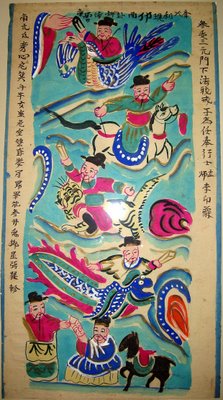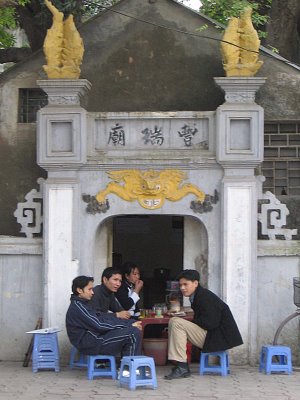The Mystery of the Painted Scrolls
 I had a full six months to do my shopping in Hanoi, but human nature being what it is, I left it to the last minute. Here is another reason why my last week in Hanoi was intense. I spent a few manic afternoons running around stores picking up things like eggshell laquer trays, rosewood chopstick sets, Hmong bookmarks and a pair of stuffed water buffaloes for my niece and nephew.
I had a full six months to do my shopping in Hanoi, but human nature being what it is, I left it to the last minute. Here is another reason why my last week in Hanoi was intense. I spent a few manic afternoons running around stores picking up things like eggshell laquer trays, rosewood chopstick sets, Hmong bookmarks and a pair of stuffed water buffaloes for my niece and nephew.I also happened upon these two paintings (click on the thumbnails for larger images). I guarded them jealously during my flight home and somehow they survived all the way to Toronto without being crushed by luggage. Now they are framed and waiting to be hung on my walls.
The problem is, I don't know what they are.
I want to try an experiment. There is so much talk these days about the role of virtual communities in the creation and sharing of knowledge. I'm not sure who out there reads my blog, but I'm hoping I can harness some of that collective brain power to help interpret these images.
 Painting # 1 (above): My friend Dat didn't know what it was, but he has a theory: these are not six different mandarins, but one. He thinks the painting depicts the adventures of this character as he rides around on sacred animals (a dragon, tiger, phoenix, white horse). He carries with him a wooden card inscribed with his name and rank. At the bottom we have what appears to be an official of some sort, and at the top we have a divine hand. Dat thought the hand belongs to a female divinity because of the fingers and the style of robe. Or is it the Jade Emperor? It's not clear which direction Mr. Mandarin is going.
Painting # 1 (above): My friend Dat didn't know what it was, but he has a theory: these are not six different mandarins, but one. He thinks the painting depicts the adventures of this character as he rides around on sacred animals (a dragon, tiger, phoenix, white horse). He carries with him a wooden card inscribed with his name and rank. At the bottom we have what appears to be an official of some sort, and at the top we have a divine hand. Dat thought the hand belongs to a female divinity because of the fingers and the style of robe. Or is it the Jade Emperor? It's not clear which direction Mr. Mandarin is going.Painting #2 (right): I wondered whether this is a Dvarapala, one of the guardians of a pagoda. The sword and the stern expression seem to suggest that he might have some role in frightening off evil spirits. These figures are usually in pairs, with one on either side of the entrance to a pagoda. The platform on which he is seated is offset so maybe there was originally another figure on the other side to provide symmetry. My friend Hung suggests instead that this is also a mandarin. Apparently the gate above his head reads "Heavenly Man".
The woman I bought them from couldn't help me. She would only tell me that they were painted by Red Dao people in the Far North of Vietnam. I am not convinced of that. I am unsure of the age of the paintings, but the paper was worn and ragged.
Anyway, those are my best guesses. I may be wildly off. I claim no expertise in these things, but would love to hear other ideas. Please make liberal use of the Comments button below.




